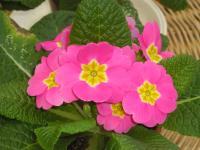Simplifying Primulas
 Over 400 species of Primula exist to tempt your fancy
Over 400 species of Primula exist to tempt your fancyThe world of Primrose nomenclature is complicated and confusing, but stick to a few basic principles, and caring for these colourful treats is far more straightforward.
There are bog primulas, woodland primulas, primroses, Polyanthus primulas, Auricula primulas, Candelabra primulas...
Unless you have loads of time on your hands and a real dedication to Primula botany it is very easy to get overwhelmed and very confused when trying to grasp and understand the genus that is Primula.
Commonly referred to as Primroses, there are over 400 species in the Primula genus and that is before you start to tackle all of the different varieties and cultivars. These perennials, often evergreen are grown as winter and spring flowering indoor container plants and used predominantly as spring flowering bedding plants in the garden.
However with climate change and warmer winters many plants are flowering at strange times and Primula varieties are flowering in my garden right now.
It is a shame that many Primula plants are discarded when they have served their purpose in a spring bedding display. If I use them for this purpose, I like to move them on rather than chuck them out, planting them in any gaps at the front of my mixed borders.
There are also Primula types not associated with seasonal bedding displays, the Drumstick Primula is one such example that would be a welcome addition to any border or herbaceous border.
If you simply want to enjoy your Primroses and care for them successfully, forget the nomenclature and focus on some basic principles of Primrose care and cultivation:
Always provide some shade for you Primroses, they enjoy normal spring light levels, but summer sun can prove rather overpowering.
- Rich, moisture retentive soil or compost is ideal for most Primulas
- When growing Primulas indoors, a heated, dark living room will cause problems. A cool, bright room is best, reduce light levels in the summer
- Dead-head spent flowers frequently and feed regularly for best flowering performance
- Water freely during flowering, less so at other times of year, letting the plant begin to dry out between waterings
- Remove any damaged or diseased leaves immediately
Follow these basic principles and you might find that these seasonal bedding plants turn into lifelong friends.
Filed under Perennials.
